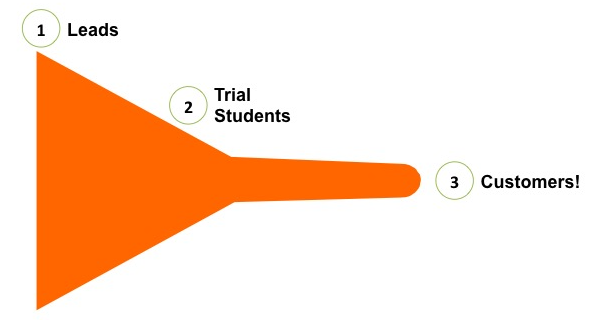6 min read
Share this post

Yet overall, it’s my work with online freelance ESL teachers that I find the most rewarding. There’s something about their energy levels and enthusiasm that I find infectious and encouraging!
Today, I’d like to discuss a theme that’s been coming up in my teacher interviews – how to sell lessons to trial ESL students. That is, once you have a student that’s interested in learning with you, how do you convert them into long-term customers?
You don’t need to be a marketing guru to understand the concept of a funnel. At the top you have all your ‘leads’. Students that have come into contact with you wether it be through social media, your blog, word-of-mouth referrals, emails or marketing campaigns. Then you have your tria l ESL students. Students that you’ve had direct communication with and are interested in taking lessons. Finally, the last step, the sale! Whether you explicitly offer trial lesson or not, there will be a point, where your ‘trial’ student is trying you out as a teacher. It’s your job to close the sale.
l ESL students. Students that you’ve had direct communication with and are interested in taking lessons. Finally, the last step, the sale! Whether you explicitly offer trial lesson or not, there will be a point, where your ‘trial’ student is trying you out as a teacher. It’s your job to close the sale.
Almost every online teacher I’ve met with seems to have one question at the top of their minds: ‘how do I find students?’ When I dig a bit deeper, I find out what they are really saying is, ‘How do I find leads’. ‘Do I need a Blog? Should it be in Wordrpess or Wix? What about Twitter? Isn’t it good to start a Facebook group? I’ve heard email marketing is the way to go?’ And so on. There seems to be an obsession with the top end of the funnel.
These days there are some fantastic resources (including Elena Mutonono and Jack Askew) that focus on strategies for setting up your online ESL business and generating leads.
I’ve found that most teachers de-emphasize a critical element of growing an ESL business: closing the sale. I’m not sure why this is. My suspicion is that the first stage in the funnel (generating leads) is the safer and more comfortable place to be. When you’re doing marketing from the safety of your computer it’s going to be more comfortable than closing a sale in direct communication with a student. Very few of us are natural-born salesman. We would rather tinker away on your blogs than be closing a sale in live communication with a student.
Of course, every step in the conversion funnel is important, but I would argue that the final sale is the most important part. You don’t want to throw away all the hard work you’ve done on getting your leads because you can’t close sales to trial ESL students.
You need a strategy on how to sell to your trial ESL students. Just showing up to your trial lessons and talking about your qualifications as a teacher isn’t going to cut it.
How do you convince your trial ESL students that you are the right choice as a language coach? From my experience, this comes down to personalization and trust. If you’re able to use a personal approach to establish trust between you and your students, you’ll be able to convert them into customers.
Recently, we released a free ESL Placement Test. The original goal of the placement test was to provide teachers with a way to set a level diagnostic for students. However, I’ve noticed an interesting strategy emerge. Many of our teachers like to send the placement test to prospective students before their first trial session together.
After their students complete the test, the tool produces a Gap Analysis (which outlines their ESL weaknesses) and an Individual Learning Plan (which outlines the lessons required to address those weaknesses). These analyses form a great tool to sell a unique learning experience to your trial ESL students. In your first session together, you can walk your students through the personalized plan you’ve crafted to address their unique language weaknesses and goals.
required to address those weaknesses). These analyses form a great tool to sell a unique learning experience to your trial ESL students. In your first session together, you can walk your students through the personalized plan you’ve crafted to address their unique language weaknesses and goals.
This level of personal attention is one example of a mechanism to build trust between you and your prospective student. Trust will be formed because you’ll be showcasing a tailored approach to your student’s needs (rather than generically trying to sell yourself based on your experience and qualifications). It’s the opposite of a one-size-fits-all approach that the student has seen before (all too common in the ELT industry).
Many of our teachers have reported a huge boost in their conversion rates by using this placement test approach on marketplaces such as italki and Verbling. So much so, that we even hosted a webinar on the subject for the italki teacher community. Chris Rush, who got 30 students in 30 days on italki and recently appeared on our blog, also emphasizes this approach when converting trial ESL students.
This strategy is not exclusively designed for online lessons or marketplaces. Whether you are teaching one-2-one online, in-person or even in-house corporate lessons, you can use our placement test to build trust and showcase a personal approach to your trial ESL students.
The best part of this strategy for busy ESL teachers is that you can use it at scale (i.e. easily-repeat it). You can send the placement test to trial students with a couple of clicks. Your student’s Gap Analysis and Individual Learning Plan will be waiting for you when you’re ready for the trial lesson. Just share your tailored analyses and impress your student!
Share this post



16 Comments
Good report, thanks.
Cheers Roy, do you have any of your own strategies to convert students into customers? Are you using our placement test in advance of consultations with trial students?
Kris
Great post! I think it’s important to get leads, but those leads do nothing for you if you don’t even try to close the sale. You can have 100 leads, but if you are not trying to close the sale, then it doesn’t matter. That is why we try to focus on quality leads that we can take our time to build a relationship with the student from the start and close the sale in every trial lesson.
I think our biggest strategy for conversion is our personal follow up emails with the potential student, along with walking them through the payment process.
Cheers Dan. Yes the payment process can definitely be a sticking point depending on if you’re working in an environment that is not so accustomed to online payments!
My question is how long in everyones opinion should I give a student to commit. Using the Off2Class current status. Which I find very restrictive a prospective student is considered a student and counts against my active students.
This limits my ability to drive more students because prospective students which I use the placement test for and they make take a few weeks decide counts against my existing and paying students.
So I am limited in how I share Off2Class
Hi Cameron, nice to hear from you. Just to clarify. No, a prospective student on Off2Class does not count against your active student count. Once you’ve reached your active student quota, you can assign the test to as many prospective students as you want. They will only be able to take the test on Off2Class (and you’ll only be able to review their results) until you activate them. Perfect for building your business. You can learn more about how this works here:
https://www.youtube.com/watch?v=gTzCXV8tpLU&list=PL37Msv5ORBscnfp4SjfPtki2ExYYGu8UY
Kind Regards
Kris
Hi Kris,
I use off to class for private in person classes and we love it.
My problem is more on fixing prices, I never know what is right.
Do you have any tips? Should I offer packages? How can I market that?
Thanks for your help!
Hi Alice! Nice to hear from you. Setting prices is a deeply personal conversation and is different for every teacher. My advice would be to price yourself as a premium product. You don’t want to be competing at the lower end of the market. You should definitely offer discounts for students that commit to longer packages with you as a reward for commitment. Kind Regards, Kris
Hi Alice, this webinar might also be useful for you. Chris discusses setting up your profile as well as price setting: https://www.off2class.com/how-to-get-online-students-30-days/
Kind Regards,
Kris
The placement test is extremely effective in determining a student’s level – and they feel like they are getting a FREEBIE which creates quite a nice bond/ bridge between teacher and prospective student. In addition, less time is wasted on material that is too easy or too challenging, so we can get up and running from lesson one. Thanks for this tool – it’s “worth its weight in gold”.
Thanks for the encouraging words! Welcome to Off2Class and glad you’re enjoying the placement test with your prospects!
Hi there. I am a language coach and have been teaching on and off on a platform. I have used it to build my skill set, and now I am ready to go at it on my own. I have taught hundreds of students from all over the world and I definitely understand the importance of trust. Now, what I am interested in doing is contacting companies that have foreign employees or the company itself is foreign in the US and promote my business with them as a language coach, for either 1 on 1 lesson for employees or coaching programs (think pronunciation, business English, etc.). I have been scouring the web to find out how I can contact businesses directly with cold emails to potentially open the door to having a conversation to hiring me, but to no avail. I need help! Do you have specific steps that you can share that will help me begin this process?
Thanks in advance!
Hi there,
That’s a great idea, and that method definitely works! There are 3 things to keep in mind. 1: It’s a numbers game. The majority of your emails won’t get replies, no matter what. Automation helps! 2. Make sure your cold emails are good, because most aren’t! There are some good blogs and sites to help with this. 3. Make sure you contact the right people. The “right person” depends on the size of the company, the region, and the industry, so doing some research helps. When I did this I had better luck with larger companies.
If you persist, you can get great results!
Any way to automate the generation of the placement test? We are going to be generating Free Trial Lessons at scale using digital marketing, and would like the placement test to be automatically generated and sent to the prospective student as soon as they sign up for the Free Trial Lesson. Any integration with Zapier or similar on the roadmap?
Hi Billy,
The placement test needs to be sent manually to prospective students. It’s better suited as an assessment tool for students who already have a certain level of commitment rather than as a lead generation tool.
Happy Teaching!
Christine
Hi Christine,
Okay, but what you’ve stated in your comment doesn’t really match the tone of this article or the strategies outlined above 🤷♂️